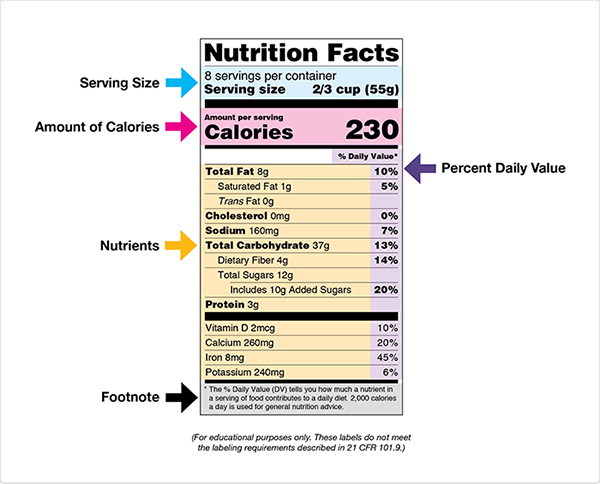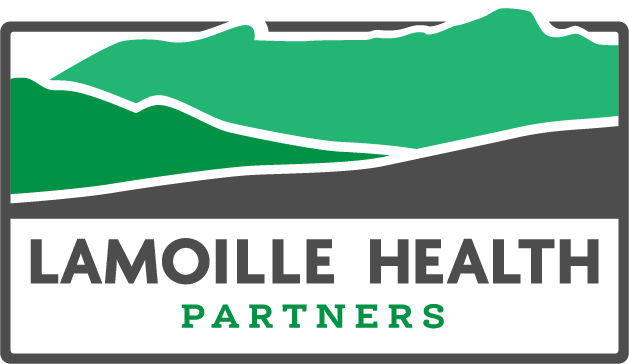By Hilary Warner, MPH, RDN
Understanding what’s in the foods and beverages we consume can help us make healthier decisions. In the United States, the Food and Drug Administration (FDA) requires all packaged foods and beverages to have a label listing nutrition and ingredient information. However, sometimes these labels can be confusing.
This article breaks down the FDA’s Nutrition Facts label into four parts. We explain each part below so you can use the information on these labels to make smart nutritional decisions for you and your family.

Serving Size
At the top of the Nutrition Facts label, you will find the total number of servings in the container and the item’s serving size. The serving size might be “cups” or “pieces,” or some other measure. For example, peanut butter is often measured with a serving of two tablespoons.
By law, serving size is based on the amount of food that people typically eat at one time. However, serving size is not always the recommendation of how much you should eat or drink- depending on your appetite and what else you are eating, the portion you eat may be less or more than the serving size on the package.
It’s important to keep in mind that all the nutrient amounts listed on the label refer to the serving size. So if you consume two servings of a packaged food or beverage — such as four tablespoons of peanut butter instead of two — you are doubling the nutrients and calorie amounts shown on the label.
Calories
Calories, listed directly below the serving size, refers to the total number of calories, or the “energy” you get from a serving of the food or beverage. The FDA requires calorie information to be displayed in a large and bold font on the label to make the information easier to find and use.
In order to maintain your weight, you must balance the number of calories you eat and drink each day with the number of calories your body burns. The FDA uses 2,000 calories a day as a general guide, but your calorie needs may be higher or lower depending on your age, gender, height, weight and physical activity level. Your Lamoille Health Partners primary care team can help you figure out the estimated calorie needs for each person in your family.
Remember that the terms “fat-free” and “no added sugars,” which can be listed on food packaging, do not mean “calorie-free” and do not necessarily mean a food is nutritious. These food items may have as many or more calories as the regular versions. Read the label to be sure.
Nutrients
Underneath the calorie information, the Nutrition Facts label lists some key nutrients that may affect your health. To support your personal dietary needs, look for foods that contain more dietary fiber, vitamin D, calcium, iron, and potassium, and less of the nutrients you may want to limit, such as saturated fat, sodium, and added sugars.
Consuming a diet high in dietary fiber can lower blood glucose and cholesterol levels and help your digestion. Diets higher in vitamin D, calcium, iron, and potassium can reduce the risk of developing osteoporosis, anemia and high blood pressure.
On the other hand, eating too much saturated fat and sodium can increase your risk of developing health conditions such as heart disease and high blood pressure. Consuming too much added sugar can cause tooth decay and negatively affect certain conditions like diabetes.
You may be unsure about the difference between what the Nutrition Facts label calls “Total Sugars” and “Added Sugars.”
- Total Sugars include sugars naturally present in many nutritious foods and beverages, such as lactose in milk or fructose in fruit.
- Added Sugars refer to the many sugars that are added during the processing of foods such as table sugar, sugars from syrups and honey, and sugars from concentrated fruit or vegetable juices.
Percent Daily Value
The column on the right side of the nutrient section of the Nutrition Facts label lists the percentage of the daily value for each nutrient in a serving of the food. The Daily Values (DV) are basic amounts of nutrients recommended each day.
For example, peanut butter usually has about two grams of fiber in two tablespoons. That is about nine percent of the total amount of fiber recommended for an adult each day. The FDA considers five percent DV or less of a nutrient per serving as low, and 20 percent DV or more as high.
Our primary care providers and Registered Dietitian Nutritionists can help you figure out the best foods that will support your unique health journey. Some people will need to eat more protein. Some need to aim for low salt intake. Others might need to avoid added sugars.
Healthy meals delivered
Lamoille Health Partners has a new program that helps our patients get the right foods on their kitchen tables, based on their health needs.
The Healthy Rural Hometown Initiative meals program, rolled out earlier this year by our Lamoille Health Partners Community Health Team, connects qualified patients with dieticians for expert one-on-one recommendations. Patients can also receive meals delivered to their homes through our partnerships with Meals on Wheels of Lamoille County and Salvation Farms, which provides patients with a box of fresh fruits and vegetables during harvest season.
The program also offers patients cooking classes and recipes as well as workshops at My Healthy Vermont that address concerns such as high blood pressure management and emotional wellness.
If you have questions about nutrition for you and your family, a healthcare professional is a good place to look for answers. To discuss your needs or to see if you qualify for the new meals program, contact your Lamoille Health Partners primary care team.

